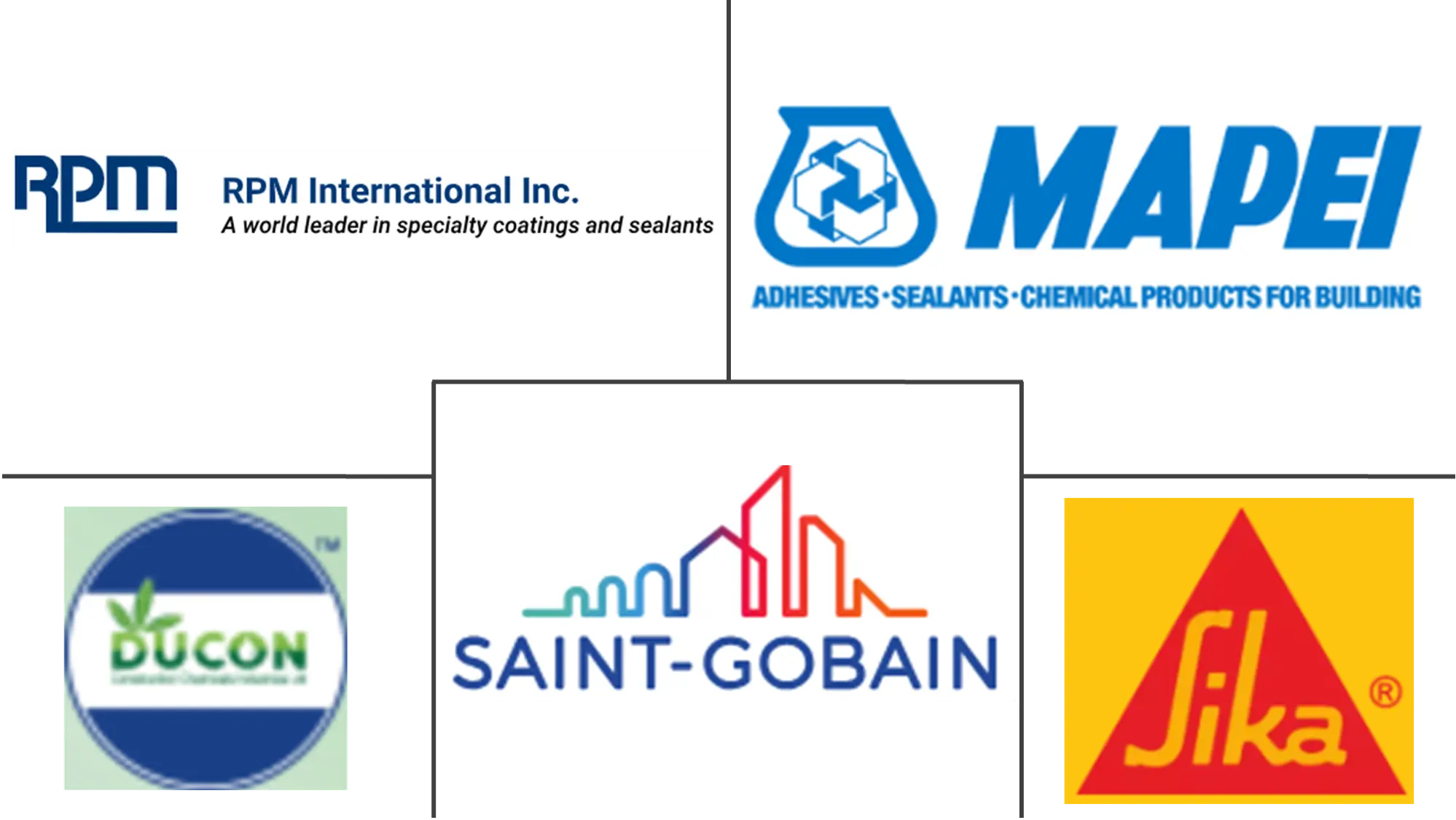Malaysia Construction Chemicals Market Size and Share
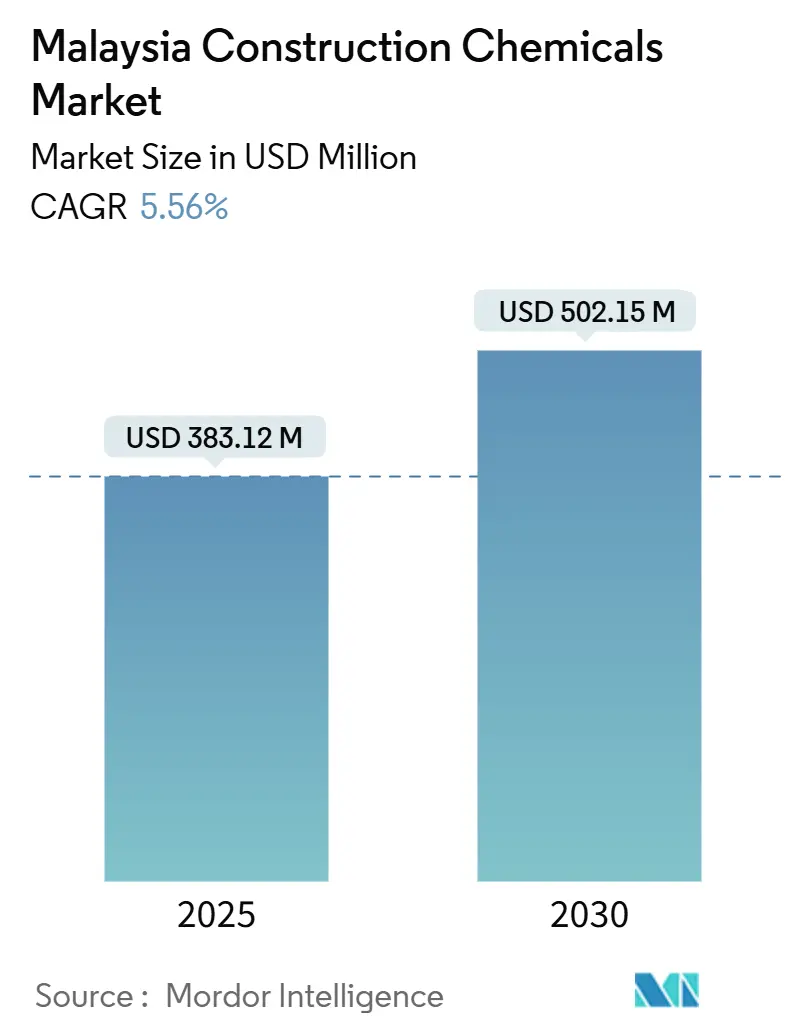
Malaysia Construction Chemicals Market Analysis by Mordor Intelligence
The Malaysia Construction Chemicals Market size is estimated at USD 383.12 million in 2025, and is expected to reach USD 502.15 million by 2030, at a CAGR of 5.56% during the forecast period (2025-2030). Sustained infrastructure momentum, including RMB 183.7 billion in projects awarded during the first 11 months of 2024, underpins steady volume growth as developers specify higher-performance admixtures, waterproofing membranes, and protective coatings. Mega-projects, such as the Johor-Singapore Special Economic Zone, signed in January 2025, are expected to accelerate demand for durable chemistries suited to marine and high-humidity environments. The Malaysia construction chemicals market also benefits from the government’s 90% BIM adoption mandate for public works, which favors precision-engineered products that integrate seamlessly with automated construction workflows. In parallel, the momentum for green-building certification stimulates the uptake of low-VOC and recyclable formulations, enabling manufacturers to command premium price points while capturing sustainability-driven opportunities.
Key Report Takeaways
- By product type, waterproofing solutions led with 49.07% revenue share of the Malaysia construction chemicals market in 2024. Surface-treatment chemicals are forecast to expand at a 7.09% CAGR through 2030.
- By end-use sector, the commercial segment accounted for a 32.63% share of the Malaysia construction chemicals market size in 2024. Industrial and institutional applications are advancing at a 6.14% CAGR through 2030.
Malaysia Construction Chemicals Market Trends and Insights
Drivers Impact Analysis
| Drivers | (~) % Impact on CAGR Forecast | Geographic Relevance | Impact Timeline |
|---|---|---|---|
| Sustainable public and private investments in infrastructure projects | +1.8% | National, with concentration in Klang Valley and Johor | Medium term (2-4 years) |
| Affordable-housing push expanding residential starts | +1.2% | National, with early gains in Selangor, Johor, Penang | Short term (≤ 2 years) |
| Green-building certification fueling demand for low-VOC and durable chemistries | +0.9% | Urban centers, particularly Kuala Lumpur and Cyberjaya | Long term (≥ 4 years) |
| Rapid adoption of ready-mix concrete and prefab raising admixture penetration | +1.1% | Industrial corridors and major metropolitan areas | Medium term (2-4 years) |
| SEZ tax breaks localising specialty-chemical production | +0.6% | Johor, Pengerang, and designated economic zones | Long term (≥ 4 years) |
| Source: Mordor Intelligence | |||
Sustainable Public and Private Infrastructure Investment Acceleration
Malaysia’s robust infrastructure pipeline, valued at RMB 183.7 billion in contracts awarded during 2024, sustains growth for specialty waterproofing membranes, polymer-modified grouts, and corrosion-inhibiting coatings used in bridges, tunnels, and urban rail systems[1]Construction Industry Development Board, “Construction Industry Statistics,” CIDB Malaysia, cidb.gov.my. The Johor-Singapore Special Economic Zone alone aims to target 50 cross-border projects within five years, thereby amplifying demand for marine-grade sealants and anti-carbonate admixtures that can withstand brackish conditions. Public-private partnerships that include manufacturing giants such as Tesla and Intel further elevate performance benchmarks, driving the development of specifications for electrostatic-dissipative flooring resins and chemical-resistant wall coatings. Upgraded roads, ports, and digital pathways attract secondary commercial projects, reinforcing a virtuous cycle of product demand across the Malaysian construction chemicals market.
Affordable Housing Programs Driving Residential Chemical Consumption
The National Housing Policy’s accelerated rollout of subsidized units standardizes the use of ready-mix concrete and prefabricated wall panels, expanding admixture volumes while tightening quality tolerances. Developers engaged in low-income housing voluntarily adopt green building criteria, fueling demand for water-based acrylic sealants and low-VOC tile adhesives that align with carbon reduction goals outlined by the Green Building Index[2]Green Building Index, “Malaysia Green Building Statistics,” greenbuildingindex.org . The policy’s geographic spread into secondary cities, such as Ipoh and Kuching, enlarges distribution networks, prompting suppliers to introduce small-pack formulations and mobile technical service teams. Cost-sensitive projects rely on high-durability yet price-competitive chemistries, incentivizing local manufacturers to scale automated production lines for consistent batch quality.
Green Building Certification Momentum Reshaping Chemical Specifications
Although certified structures still represent a small percent of the domestic floor area, the Green Building Index and GreenRE schemes redefine the baseline performance criteria for sealants, coatings, and flooring systems across the Malaysian construction chemicals market. International tenants are increasingly mandating ISO 14001-aligned facilities, compelling project teams to specify low-formaldehyde epoxies and solvent-free polyurethane membranes, despite higher upfront costs. Building performance data collected through certification audits feed back into formulation research and development, accelerating the introduction of bio-based plasticizers and recycled-content fillers. Government agencies incorporate these standards into public procurement, gradually mainstreaming premium chemistries that were once niche offerings.
Ready-Mix Concrete and Prefabrication Technology Integration
Mandated 90% BIM utilization on public projects necessitates admixtures with predictable slump retention and rapid early-strength gain compatible with digitally modeled curing profiles. Prefabrication plants rely on high-workability superplasticizers and surface-treatment release agents that are calibrated for use with automated casting tables, thereby minimizing rework and scrap. IoT-enabled sensors embedded in structural members monitor hydration kinetics, opening avenues for smart-chemistry packages that deliver real-time feedback to site managers. The Malaysia construction chemicals market thereby shifts from commodity sales toward data-enhanced solutions tied to lifecycle-performance contracts.
Restraints Impact Analysis
| Restraints | (~) % Impact on CAGR Forecast | Geographic Relevance | Impact Timeline |
|---|---|---|---|
| Feedstock price volatility squeezing producer margins | -1.4% | National, with higher impact on import-dependent manufacturers | Short term (≤ 2 years) |
| Rising EHS compliance costs (VOC, hazardous solvent bans) | -0.8% | Industrial areas and urban centers with stricter enforcement | Medium term (2-4 years) |
| Shortage of trained applicators for advanced chemistries | -0.7% | National, with acute impact in secondary cities and rural areas | Medium term (2-4 years) |
| Source: Mordor Intelligence | |||
Feedstock Price Volatility Constraining Market Expansion
Imported polymers, specialty solvents, and performance additives account for up to 60% of the raw material cost in premium formulations, exposing manufacturers to currency fluctuations and crude oil price spikes. PETRONAS has locked in forward supply contracts through 2026, but small and mid-sized players purchase on spot terms, eroding EBITDA margins when feedstock costs rise. The Pengerang-based USD 3.5 billion petrochemical complex, under construction since mid-2025, will enhance local supply integration but is not expected to reach nameplate output before 2028. Until then, volatility may accelerate consolidation as under-capitalized firms cede share to integrated multinationals.
Environmental Health and Safety Compliance Cost Escalation
Malaysia’s amended Occupational Safety and Health Act of 2024 imposes stricter rules for storage, labeling, and waste handling, which raises overhead for solvent-borne adhesive producers. Anticipated regional restrictions on long-chain perfluoroalkyl compounds will compel costly reformulations for water-repellent admixtures and protective coatings. Compliance spending—including emission-control equipment and employee training—may reach 8% of annual revenue for traditional manufacturers, reinforcing the competitive advantage of companies that have already invested in greener chemistries.
Segment Analysis
By Product: Waterproofing Dominance Amid Surface Treatment Innovation
Waterproofing solutions captured 49.07% of the Malaysian construction chemicals market share in 2024, driven by mandatory rooftop and podium deck specifications in high-rise developments across Kuala Lumpur and Johor Bahru. Bitumen-modified membranes retain their leadership in volume, while polymer-cementitious hybrids gain favor for their rapid-setting underground applications. The Malaysian construction chemicals market size for waterproofing is projected to expand in lockstep with transit-oriented developments, ports, and data center basements that require a long service life in humid conditions.
Surface-treatment chemicals are expected to register the fastest 7.09% CAGR through 2030, driven by advanced curing agents and mold-release emulsions optimized for precast façade panels. Anti-graffiti sealers and hydrophobic silane gels enjoy rising demand from municipal infrastructure programs aimed at reducing maintenance costs. Innovation is pivoting toward nano-engineered particles that enhance abrasion resistance without increasing VOC levels, aligning with green-building credits.
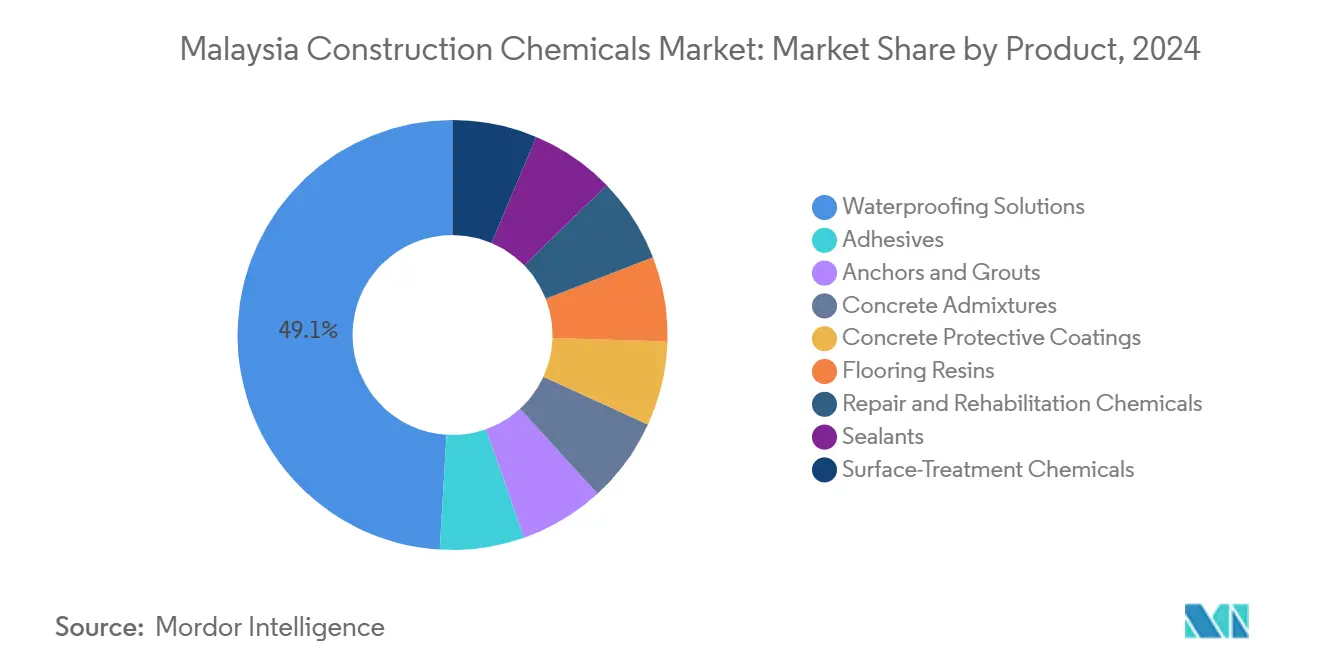
Note: Segment shares of all individual segments available upon report purchase
By End-Use Sector: Commercial Leadership with Industrial Acceleration
Commercial real-estate projects—including office towers, retail complexes, and hospitality venues—held a 32.63% share of the Malaysian construction chemicals market in 2024, driven by multinational tenants seeking Grade-A facilities with premium flooring resins and low-VOC indoor air solutions. Developers in Klang Valley install polyurethane-cement screeds and epoxy terrazzo systems that tolerate high foot traffic while achieving LEED and GBI certifications.
Industrial and institutional construction posts a 6.14% CAGR, the fastest among all segments, buoyed by electronics and EV supply-chain investments under the National Investment Policy 2030. Semiconductor fabs demand antistatic flooring and zero-siloxane joint sealants to safeguard cleanroom integrity. Pharmaceutical plants specify hydrophobic grouts and antimicrobial wall coatings, expanding the Malaysia construction chemicals market size for specialty formulations tailored to stringent GMP standards.
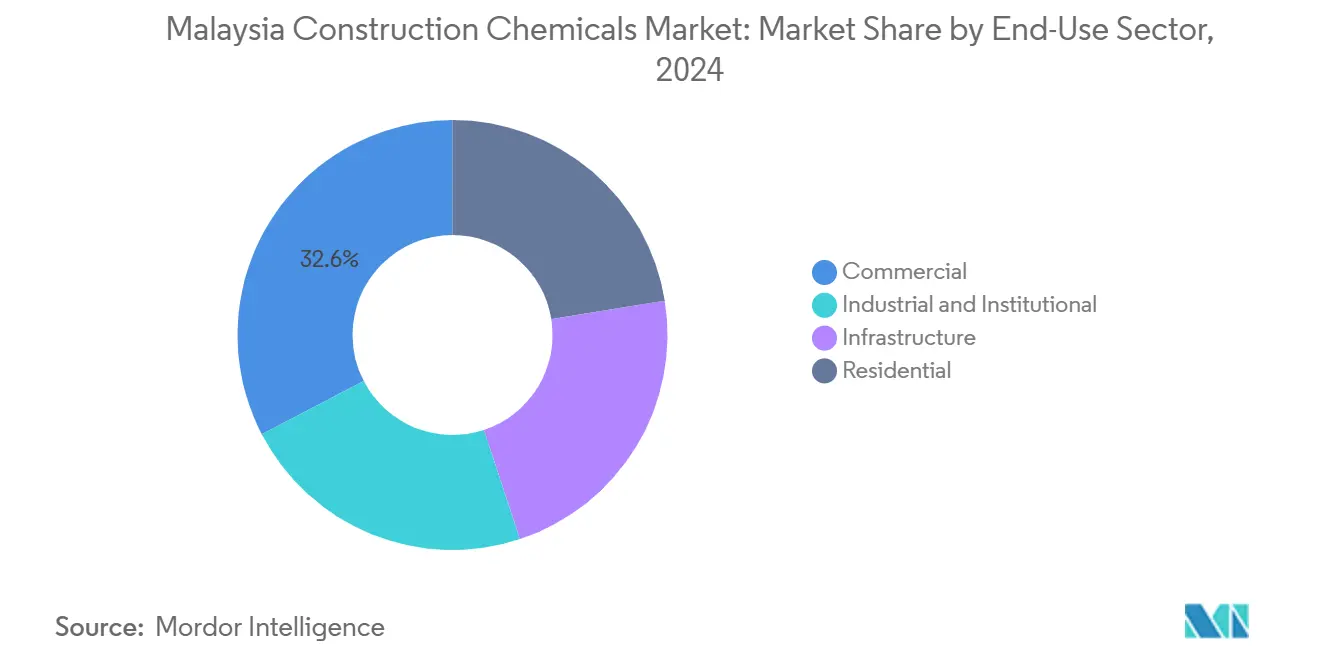
Note: Segment shares of all individual segments available upon report purchase
Geography Analysis
Klang Valley anchors demand with a dense pipeline of transit-linked residential towers and data-center campuses that consume premium admixtures, fire-resistant coatings, and hybrid waterproofing membranes. Johor’s cross-border ecosystem, catalyzed by the Johor-Singapore Special Economic Zone, compels suppliers to stock marine-grade expansion joint systems suited to tidal influences. Pengerang emerges as a dual play—providing backward integration for resin feedstocks while spurring demand for corrosion-protection coatings during refinery and storage-tank construction.
Penang’s electronics cluster accelerates orders for low-chloride grouts and dust-free epoxy flooring, reflecting stringent ISO-class requirements in chip-assembly lines. Cyberjaya pioneers green-building innovation, with tech campuses incorporating bio-based polyurethane sealers and silicon carbide-enhanced surface hardeners to meet corporate sustainability obligations. Secondary cities, such as Kuching and Kota Kinabalu, benefit from federal affordable-housing grants, which in turn boost the consumption of ready-mix-compatible admixtures and economical tile adhesives as distribution networks mature.
East-coast industrial parks, though smaller in absolute value, exhibit above-average growth as manufacturers relocate for lower land costs, requiring infrastructure-grade waterproofing and sulfate-resistant admixtures. Municipality enforcement of Department of Standards Malaysia codes ensures uniform material performance, narrowing quality gaps between urban and regional builds.
Competitive Landscape
International majors hold technology leadership yet face margin pressure from volatile feedstock costs. Local players differentiate themselves through cost-effective waterproofing powders and specialty fiber-reinforced mortars, targeting mid-tier contractors. Their nimble distribution networks command loyalty in secondary towns, yet limited research and development outlays constrain their entry into high-specification niches. Digitalization emerges as the next battleground: leading suppliers are embedding QR-coded batch data and mobile-app dosage calculators to integrate with BIM models, delivering transparency and reducing on-site errors. Firms investing in EPD-certified products and solvent-free technologies position themselves favorably for future regulatory tightening and corporate net-zero pledges.
Malaysia Construction Chemicals Industry Leaders
-
Sika AG
-
MAPEI S.p.A.
-
Saint-Gobain
-
Ducon Construction Chemicals
-
RPM International
- *Disclaimer: Major Players sorted in no particular order
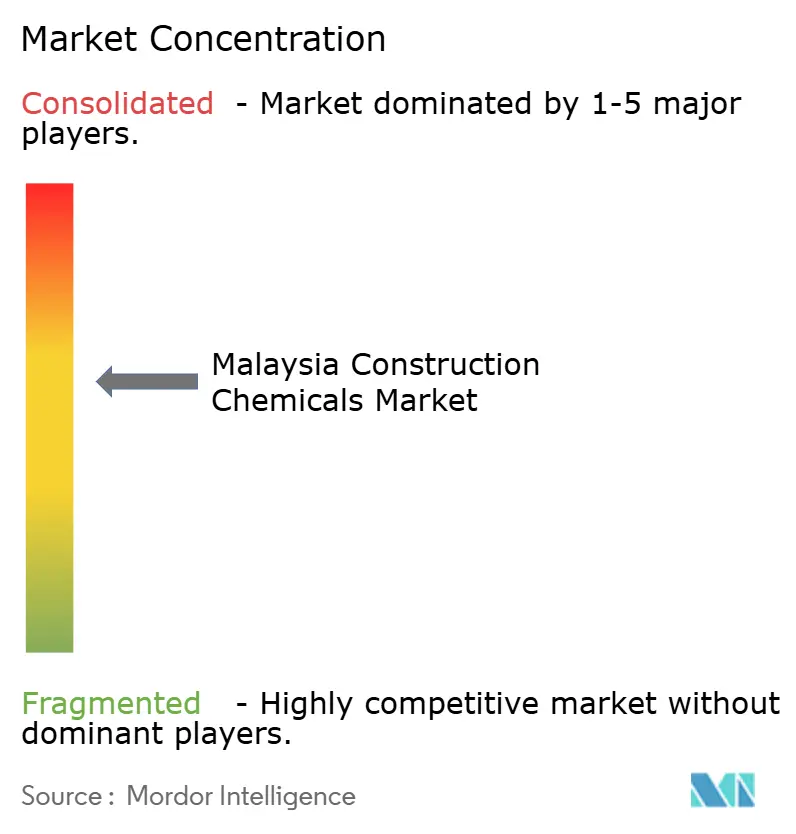
Recent Industry Developments
- February 2025: Saint-Gobain has finalized its acquisition of Fosroc, a prominent global player in construction chemicals, significantly enhancing its presence across India, the Middle East, and the Asia-Pacific region. This strategic move, announced in June 2024 and completed in February 2025, marks a pivotal expansion of Saint-Gobain’s construction chemicals portfolio.
- September 2024: Bostik, a solution provider of adhesives and sealants and part of the Arkema Group, introduced Fast Glue Ultra+, an adhesive formulated with 60% bio-based materials. This innovation marks a significant advancement in sustainable construction chemicals.
Malaysia Construction Chemicals Market Report Scope
Commercial, Industrial and Institutional, Infrastructure, Residential are covered as segments by End Use Sector. Adhesives, Anchors and Grouts, Concrete Admixtures, Concrete Protective Coatings, Flooring Resins, Repair and Rehabilitation Chemicals, Sealants, Surface Treatment Chemicals, Waterproofing Solutions are covered as segments by Product.| Adhesives | Hot-Melt |
| Reactive | |
| Solvent-borne | |
| Water-borne | |
| Anchors and Grouts | Cementitious Fixing |
| Resin Fixing | |
| Concrete Admixtures | Accelerator |
| Air-Entraining | |
| Super-plasticizer | |
| Retarder | |
| Shrinkage-Reducer | |
| Viscosity-Modifier | |
| Plasticizer | |
| Other Types | |
| Concrete Protective Coatings | Acrylic |
| Alkyd | |
| Epoxy | |
| Polyurethane | |
| Other Resins | |
| Flooring Resins | Acrylic |
| Epoxy | |
| Polyaspartic | |
| Polyurethane | |
| Other Resins | |
| Repair and Rehabilitation Chemicals | Fiber-Wrapping Systems |
| Injection Grouting | |
| Micro-concrete Mortars | |
| Modified Mortars | |
| Rebar Protectors | |
| Sealants | Acrylic |
| Epoxy | |
| Polyurethane | |
| Silicone | |
| Other Resins | |
| Surface-Treatment Chemicals | Curing Compounds |
| Mold-Release Agents | |
| Other Types | |
| Waterproofing Solutions | Chemicals |
| Membranes |
| Commercial |
| Industrial and Institutional |
| Infrastructure |
| Residential |
| By Product | Adhesives | Hot-Melt |
| Reactive | ||
| Solvent-borne | ||
| Water-borne | ||
| Anchors and Grouts | Cementitious Fixing | |
| Resin Fixing | ||
| Concrete Admixtures | Accelerator | |
| Air-Entraining | ||
| Super-plasticizer | ||
| Retarder | ||
| Shrinkage-Reducer | ||
| Viscosity-Modifier | ||
| Plasticizer | ||
| Other Types | ||
| Concrete Protective Coatings | Acrylic | |
| Alkyd | ||
| Epoxy | ||
| Polyurethane | ||
| Other Resins | ||
| Flooring Resins | Acrylic | |
| Epoxy | ||
| Polyaspartic | ||
| Polyurethane | ||
| Other Resins | ||
| Repair and Rehabilitation Chemicals | Fiber-Wrapping Systems | |
| Injection Grouting | ||
| Micro-concrete Mortars | ||
| Modified Mortars | ||
| Rebar Protectors | ||
| Sealants | Acrylic | |
| Epoxy | ||
| Polyurethane | ||
| Silicone | ||
| Other Resins | ||
| Surface-Treatment Chemicals | Curing Compounds | |
| Mold-Release Agents | ||
| Other Types | ||
| Waterproofing Solutions | Chemicals | |
| Membranes | ||
| By End-Use Sector | Commercial | |
| Industrial and Institutional | ||
| Infrastructure | ||
| Residential | ||
Market Definition
- END-USE SECTOR - Construction chemicals consumed in the construction sectors such as commercial, residential, industrial, institutional, and infrastructure are considered under the scope of the study.
- PRODUCT/APPLICATION - Under the scope of the study, the consumption of construction chemical products such as concrete admixtures, repair and rehabilitation chemicals, flooring resins, waterproofing solutions, anchors and grouts, adhesives and sealants, and surface treatment chemicals is considered.
| Keyword | Definition |
|---|---|
| Accelerator | Accelerators are admixtures used to fasten the setting time of concrete by increasing the initial rate and speeding up the chemical reaction between cement and the mixing water. These are used to harden and increase the strength of concrete quickly. |
| Acrylic | This synthetic resin is a derivative of acrylic acid. It forms a smooth surface and is mainly used for various indoor applications. The material can also be used for outdoor applications with a special formulation. |
| Adhesives | Adhesives are bonding agents used to join materials by gluing. Adhesives can be used in construction for many applications, such as carpet laying, ceramic tiles, countertop lamination, etc. |
| Air Entraining Admixture | Air-entraining admixtures are used to improve the performance and durability of concrete. Once added, they create uniformly distributed small air bubbles to impart enhanced properties to the fresh and hardened concrete. |
| Alkyd | Alkyds are used in solvent-based paints such as construction and automotive paints, traffic paints, flooring resins, protective coatings for concrete, etc. Alkyd resins are formed by the reaction of an oil (fatty acid), a polyunsaturated alcohol (Polyol), and a polyunsaturated acid or anhydride. |
| Anchors and Grouts | Anchors and grouts are construction chemicals that stabilize and improve the strength and durability of foundations and structures like buildings, bridges, dams, etc. |
| Cementitious Fixing | Cementitious fixing is a process in which a cement-based grout is pumped under pressure to fill forms, voids, and cracks. It can be used in several settings, including bridges, marine applications, dams, and rock anchors. |
| Commercial Construction | Commercial construction comprises new construction of warehouses, malls, shops, offices, hotels, restaurants, cinemas, theatres, etc. |
| Concrete Admixtures | Concrete admixtures comprise water reducers, air entrainers, retarders, accelerators, superplasticizers, etc., added to concrete before or during mixing to modify its properties. |
| Concrete Protective Coatings | To provide specific protection, such as anti-carbonation or chemical resistance, a film-forming protective coat can be applied on the surface. Depending on the applications, different resins like epoxy, polyurethane, and acrylic can be used for concrete protective coatings. |
| Curing Compounds | Curing compounds are used to cure the surface of concrete structures, including columns, beams, slabs, and others. These curing compounds keep the moisture inside the concrete to give maximum strength and durability. |
| Epoxy | Epoxy is known for its strong adhesive qualities, making it a versatile product in many industries. It resists heat and chemical applications, making it an ideal product for anyone needing a stronghold under pressure. It is widely used in adhesives, electrical and electronics, paints, etc. |
| Fiber Wrapping Systems | Fiber Wrapping Systems are a part of construction repair and rehabilitation chemicals. It involves the strengthening of existing structures by wrapping structural members like beams and columns with glass or carbon fiber sheets. |
| Flooring Resins | Flooring resins are synthetic materials applied to floors to enhance their appearance, increase their resistance to wear and tear or provide protection from chemicals, moisture, and stains. Depending on the desired properties and the specific application, flooring resins are available in distinct types, such as epoxy, polyurethane, and acrylic. |
| High-Range Water Reducer (Super Plasticizer) | High-range water reducers are a type of concrete admixture that provides enhanced and improved properties when added to concrete. These are also called superplasticizers and are used to decrease the water-to-cement ratio in concrete. |
| Hot Melt Adhesives | Hot-melt adhesives are thermoplastic bonding materials applied as melts that achieve a solid state and resultant strength on cooling. They are commonly used for packaging, coatings, sanitary products, and tapes. |
| Industrial and Institutional Construction | Industrial and institutional construction includes new construction of hospitals, schools, manufacturing units, energy and power plants, etc. |
| Infrastructure Construction | Infrastructure construction includes new construction of railways, roads, seaways, airports, bridges, highways, etc. |
| Injection Grouting | The process of injecting grout into open joints, cracks, voids, or honeycombs in concrete or masonry structural members is known as injection grouting. It offers several benefits, such as strengthening a structure and preventing water infiltration. |
| Liquid-Applied Waterproofing Membranes | Liquid-Applied membrane is a monolithic, fully bonded, liquid-based coating suitable for many waterproofing applications. The coating cures to form a rubber-like elastomeric waterproof membrane and may be applied over many substrates, including asphalt, bitumen, and concrete. |
| Micro-concrete Mortars | Micro-concrete mortar is made up of cement, water-based resin, additives, mineral pigments, and polymers and can be applied on both horizontal and vertical surfaces. It can be used to refurbish residential complexes, commercial spaces, etc. |
| Modified Mortars | Modified Mortars include Portland cement and sand along with latex/polymer additives. The additives increase adhesion, strength, and shock resistance while also reducing water absorption. |
| Mold Release Agents | Mold release agents are sprayed or coated on the surface of molds to prevent a substrate from bonding to a molding surface. Several types of mold release agents, including silicone, lubricant, wax, fluorocarbons, and others, are used based on the type of substrates, including metals, steel, wood, rubber, plastic, and others. |
| Polyaspartic | Polyaspartic is a subset of polyurea. Polyaspartic floor coatings are typically two-part systems that consist of a resin and a catalyst to ease the curing process. It offers high durability and can withstand harsh environments. |
| Polyurethane | Polyurethane is a plastic material that exists in various forms. It can be tailored to be either rigid or flexible and is the material of choice for a broad range of end-user applications, such as adhesives, coatings, building insulation, etc. |
| Reactive Adhesives | A reactive adhesive is made of monomers that react in the adhesive curing process and do not evaporate from the film during use. Instead, these volatile components become chemically incorporated into the adhesive. |
| Rebar Protectors | In concrete structures, rebar is one of the important components, and its deterioration due to corrosion is a major issue that affects the safety, durability, and life span of buildings and structures. For this reason, rebar protectors are used to protect against degrading effects, especially in infrastructure and industrial construction. |
| Repair and Rehabilitation Chemicals | Repair and Rehabilitation Chemicals include repair mortars, injection grouting materials, fiber wrapping systems, micro-concrete mortars, etc., used to repair and restore existing buildings and structures. |
| Residential Construction | Residential construction involves constructing new houses or spaces like condominiums, villas, and landed homes. |
| Resin Fixing | The process of using resins like epoxy and polyurethane for grouting applications is called resin fixing. Resin fixing offers several advantages, such as high compressive and tensile strength, negligible shrinkage, and greater chemical resistance compared to cementitious fixing. |
| Retarder | Retarders are admixtures used to slow down the setting time of concrete. These are usually added with a dosage rate of around 0.2% -0.6% by weight of cement. These admixtures slow down hydration or lower the rate at which water penetrates the cement particles by making concrete workable for a long time. |
| Sealants | A sealant is a viscous material that has little or no flow qualities, which causes it to remain on surfaces where they are applied. Sealants can also be thinner, enabling penetration to a certain substance through capillary action. |
| Sheet Waterproofing Membranes | Sheet membrane systems are reliable and durable thermoplastic waterproofing solutions that are used for waterproofing applications even in the most demanding below-ground structures, including those exposed to highly aggressive ground conditions and stress. |
| Shrinkage Reducing Admixture | Shrinkage-reducing admixtures are used to reduce concrete shrinkage, whether from drying or self-desiccation. |
| Silicone | Silicone is a polymer that contains silicon combined with carbon, hydrogen, oxygen, and, in some cases, other elements. It is an inert synthetic compound that comes in various forms, such as oil, rubber, and resin. Due to its heat-resistant properties, it finds applications in sealants, adhesives, lubricants, etc. |
| Solvent-borne Adhesives | Solvent-borne adhesives are mixtures of solvents and thermoplastic or slightly cross-linked polymers such as polychloroprene, polyurethane, acrylic, silicone, and natural and synthetic rubbers. |
| Surface Treatment Chemicals | Surface treatment chemicals are chemicals used to treat concrete surfaces, including roofs, vertical surfaces, and others. They act as curing compounds, demolding agents, rust removers, and others. They are cost-effective and can be used on roadways, pavements, parking lots, and others. |
| Viscosity Modifier | Viscosity Modifiers are concrete admixtures used to change various properties of admixtures, including viscosity, workability, cohesiveness, and others. These are usually added with a dosage of around 0.01% to 0.1% by weight of cement. |
| Water Reducer | Water reducers, also called plasticizers, are a type of admixture used to decrease the water-to-cement ratio in the concrete, thereby increasing the durability and strength of concrete. Various water reducers include refined lignosulfonates, gluconates, hydroxycarboxylic acids, sugar acids, and others. |
| Water-borne Adhesives | Water-borne adhesives use water as a carrier or diluting medium to disperse resin. They are set by allowing the water to evaporate or be absorbed by the substrate. These adhesives are compounded with water as a dilutant rather than a volatile organic solvent. |
| Waterproofing Chemicals | Waterproofing chemicals are designed to protect a surface from the perils of leakage. A waterproofing chemical is a protective coating or primer applied to a structure's roof, retaining walls, or basement. |
| Waterproofing Membranes | Waterproofing membranes are liquid-applied or self-adhering layers of water-tight materials that prevent water from penetrating or damaging a structure when applied to roofs, walls, foundations, basements, bathrooms, and other areas exposed to moisture or water. |
Research Methodology
Mordor Intelligence follows a four-step methodology in all our reports.
- Step-1: Identify Key Variables: The quantifiable key variables (industry and extraneous) pertaining to the specific product segment and country are selected from a group of relevant variables & factors based on desk research & literature review; along with primary expert inputs. These variables are further confirmed through regression modeling (wherever required).
- Step-2: Build a Market Model: In order to build a robust forecasting methodology, the variables and factors identified in Step-1 are tested against available historical market numbers. Through an iterative process, the variables required for market forecast are set and the model is built on the basis of these variables.
- Step-3: Validate and Finalize: In this important step, all market numbers, variables and analyst calls are validated through an extensive network of primary research experts from the market studied. The respondents are selected across levels and functions to generate a holistic picture of the market studied.
- Step-4: Research Outputs: Syndicated Reports, Custom Consulting Assignments, Databases & Subscription Platforms
